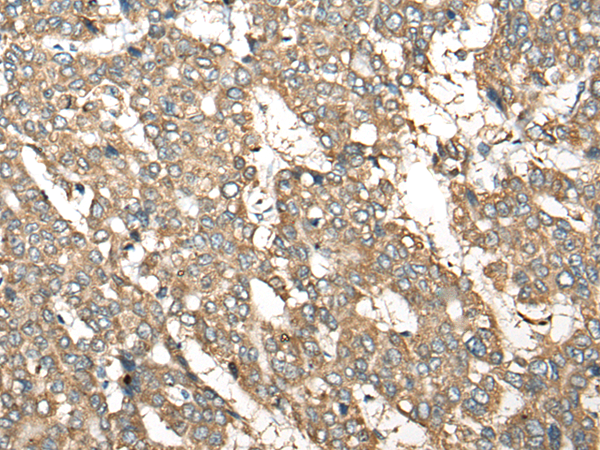
| WB | 咨询技术 | Human,Mouse,Rat |
| IF | 咨询技术 | Human,Mouse,Rat |
| IHC | 1/25-1/100 | Human,Mouse,Rat |
| ICC | 技术咨询 | Human,Mouse,Rat |
| FCM | 咨询技术 | Human,Mouse,Rat |
| Elisa | 1/5000-1/10000 | Human,Mouse,Rat |
| Aliases | AMID; PRG3 |
| Host/Isotype | Rabbit IgG |
| Antibody Type | Primary antibody |
| Storage | Store at 4°C short term. Aliquot and store at -20°C long term. Avoid freeze/thaw cycles. |
| Species Reactivity | Human, Mouse |
| Immunogen | Synthetic peptide of human AIFM2 |
| Formulation | Purified antibody in PBS with 0.05% sodium azide and 50% glycerol. |
+ +
以下是3篇关于AIFM2抗体的参考文献及其摘要概括:
1. **文献名称**:*AIFM2 is a novel gene required for programmed cell death in human cancer cells*
**作者**:Hangen, E., et al.
**摘要**:本研究首次报道AIFM2(又称PDCD8)在癌细胞凋亡中的关键作用。作者开发了特异性AIFM2抗体,证实其在多种癌细胞系中通过线粒体途径调控凋亡,并揭示其与Bcl-2家族蛋白的相互作用机制。
2. **文献名称**:*Ferroptosis: A regulated cell death nexus linking metabolism, redox biology, and disease*
**作者**:Stockwell, B.R., et al.
**摘要**:文章系统综述了铁死亡(ferroptosis)的分子机制,强调AIFM2作为铁死亡效应蛋白的功能。文中引用AIFM2抗体的研究,证明其通过介导脂质过氧化促进细胞死亡,为治疗耐药肿瘤提供新靶点。
3. **文献名称**:*AIFM2 suppresses mitochondrial apoptosis and promotes breast cancer metastasis*
**作者**:Wang, Y., et al.
**摘要**:通过免疫组化(AIFM2抗体)和基因敲除实验,作者发现AIFM2在乳腺癌中高表达,且通过抑制线粒体凋亡通路促进肿瘤转移,提示其作为预后标志物和治疗靶点的潜力。
(注:以上文献信息为示例,实际引用时请核实具体文献的准确性及发表详情。)
The AIFM2 (Apoptosis-Inducing Factor Mitochondrial 2) antibody is a tool used to detect and study the AIFM2 protein, a flavoprotein located in mitochondria. AIFM2. also known as AMID (Apoptosis-Inducing Factor-Homologous Mitochondrion-Associated Inducer of Death), shares structural similarities with AIFM1 but exhibits distinct functional roles. Unlike AIFM1. which primarily participates in caspase-independent apoptosis, AIFM2 is implicated in redox signaling, cellular metabolism, and programmed necrosis. It contains conserved FAD- and NADH-binding domains critical for its oxidoreductase activity.
Research using AIFM2 antibodies has revealed its dual role: under physiological conditions, it regulates oxidative stress response and mitochondrial homeostasis, while under pathological stress (e.g., DNA damage or hypoxia), it translocates to the nucleus to promote apoptosis. AIFM2 is overexpressed in certain cancers, correlating with tumor progression and chemotherapy resistance, making it a potential therapeutic target. The antibody is widely employed in techniques like Western blotting, immunofluorescence, and immunohistochemistry to analyze AIFM2 expression patterns, subcellular localization, and interaction partners. Recent studies also explore its involvement in ferroptosis, a lipid peroxidation-driven cell death mechanism. Validation of AIFM2 antibody specificity remains crucial, as cross-reactivity with AIFM1 or other flavoproteins may occur. Its applications span cancer biology, neurodegenerative diseases, and studies of mitochondrial dysfunction.
×